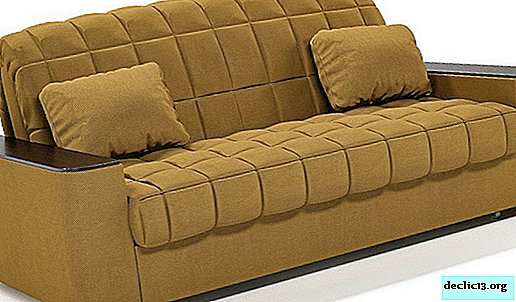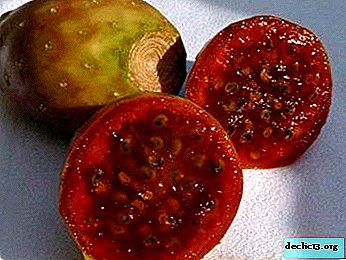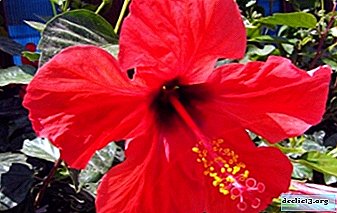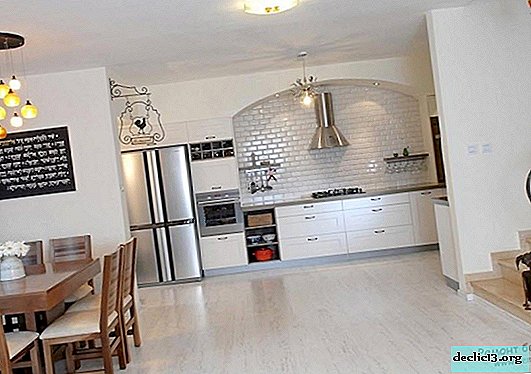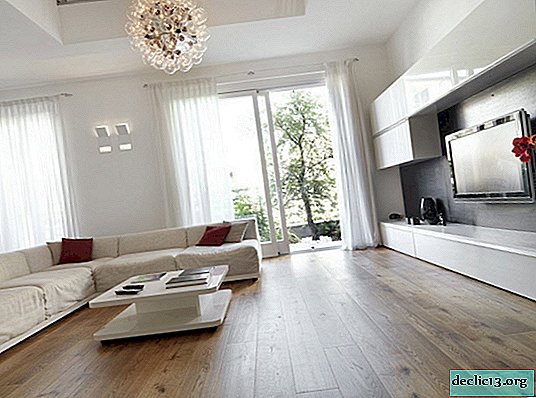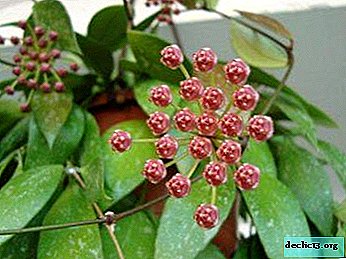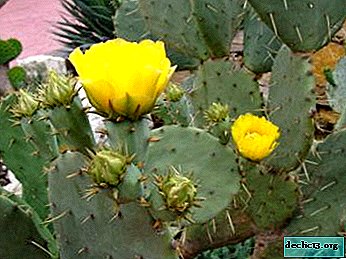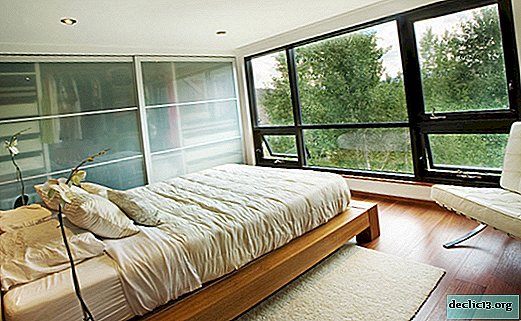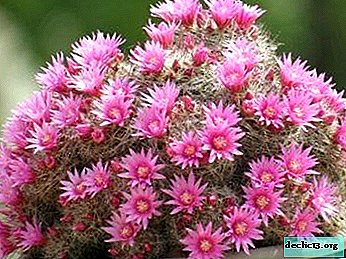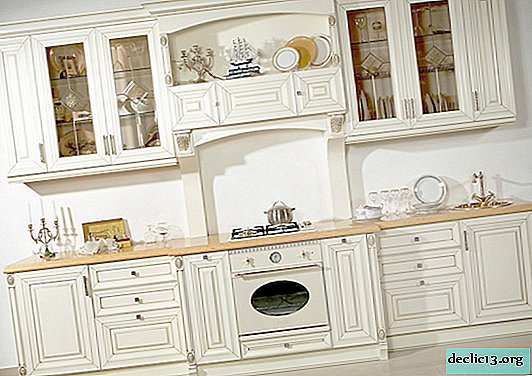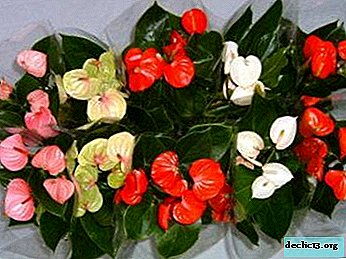Making knitted bedspreads with knitting needles and crochet
Knitted home textiles have not lost their relevance for several seasons. This is not surprising, because things made of yarn are always associated with special comfort, a feeling of warmth. Among the whole variety of products, knitted bedspreads are in great demand today, organically fitting into any design style. Such interior items can be purchased in the store or made by yourself, adding a touch of originality to the design of your own bedroom.
Features and Benefits
Knitted blanket on the bed looks homely and at the same time stylish. You can pick up products made in different ways, connected by interesting patterns, styles. Such bedspreads have many advantages:
- Knitted home textiles are perfect for a children's room, bedroom, living room.
- Simple care. Knitted bedspreads perfectly tolerate machine wash at a temperature of 30-40 ° C.
- The ability to independently make a product of any size, color.
- A wide range of yarn in various colors, many patterns for the manufacture of bedspreads allows you to get an exclusive plaid.
- In the process of knitting, each stage is controlled, from the selection of yarn to the choice of the pattern of the future plaid. You do not have to choose between the appropriate size, color and design of finished products.
- Affordable cost. Handmade ready-made blankets will not be cheap, however, you can significantly save by making home textiles with your own hands.
In cases where it is not possible to independently tie the bedspread, you can order the product in a special store or from the craftswomen, after discussing all the nuances.
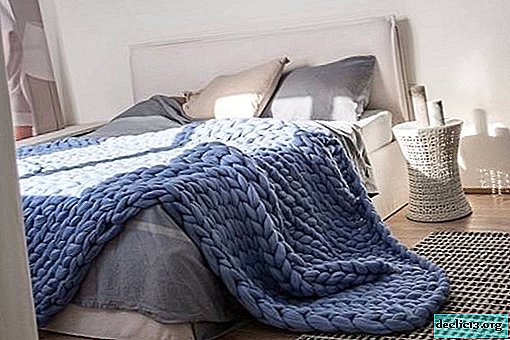
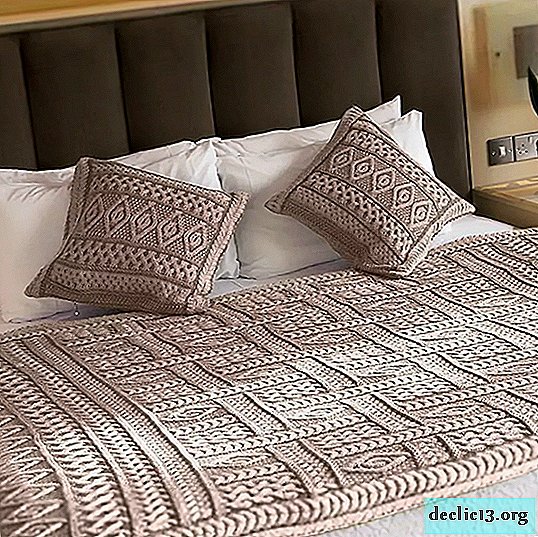



Varieties
The knitted bedspread in the bedroom can be made by various methods, each of which has its own characteristics:
- Machine binding. If needlework does not attract the hostess, you can purchase the finished product in the store. In addition, there is the opportunity to buy a knitted fabric knitting. As a rule, the roll has a standard length and after the necessary footage has been cut, all that remains is to process the edges. This can be done using overlock or oblique satin inlay. Processing with light silk and a contrasting fabric will look beautiful.
- Hand knitting. It is the most affordable method of manufacturing a fashion accessory for the interior. Even the simplest technique will allow you to get a very nice product. If you choose large knitting needles and thick threads, it will take a little time to make a plaid. The main thing is to remember that the simpler the pattern, the more accurately the blanket will turn out. In the process of knitting, you need to try so that the loops are the same size, do not break out of the general row.
- Crochet. This tool is easier to make a small plaid, because this technique requires a large number of loops, and it is much more difficult to maintain the shape. You can use the technique in which the parts are connected using additional columns in a single canvas. Crocheted bedspread for bed is perfect for a country style bedroom or provence. Such products are often not able to fulfill the function of a plaid, which can be wrapped in a cool autumn evening, because it turns out to be openwork and light. However, outwardly they are very reminiscent of lace and decorate the interior.
When choosing a pattern, you must understand that any of them is performed by different threads. The dimensions of the bedspread depend on their thickness, so you can take the tablecloth scheme as the basis, but use dense wool as the material, not cotton.
 Machine knitting
Machine knitting Knitting needles
Knitting needles Crochet
CrochetUsed yarn
The right choice of material largely determines the final result. The finished product should not cause allergies and be difficult to maintain.. In addition, yarn directly affects the complexity of manufacturing the bedspreads, the appearance and cost of the product. As a rule, for knitting a bedspread is used:
- Wool. The most popular material for making a knitted bedspread. For work, wool of sheep, goat, merino, alpaca, camel, rabbit is used. Products from such a thread have a massage effect, warm, and the bedspread “breathes”. Blankets made of material require delicate washing with special tools. Natural allergic products are contraindicated.
- Cotton thread is suitable for making openwork bedspreads. Such products are easy to wash, they are very pleasant to the touch. The properties of viscose, bamboo and silk have similar properties.
- Synthetic yarn obtained by industrial methods is also suitable for the manufacture of bedspreads. Such products are particularly soft and splendid. The material has a rather small cost, but plaids from such threads do not breathe, are electrified and quickly lose their appearance.
- Blended yarn is an ideal solution for the ratio of cost and quality indicators. Plaids of this type are more comfortable than synthetic ones, but will not be pricked like bedspreads from wool.
- Thick yarn. Its main types: knitted, velor, plush. The last two options are composed of one hundred percent micropolyester (a thread evenly coated with a dense soft and silky pile). Products made from such material are surprisingly gentle and comfortable. The color palette of yarn is very diverse, the knitting process itself brings a lot of pleasure. A bedspread from such a thread will be very soft and fluffy. Knitted yarn products have an interesting texture and are surprisingly flexible. The bedspreads are wear-resistant, and the price of the material will please.
What material to choose for bedspreads on the bed is an individual question. Thick yarn will be good for beginners, knitting from it is easier and faster. Moreover, the quality of the product will not suffer.
Plaids from bulk thick yarn are difficult to care for, it is quite problematic to wash them. If one of the family members has a tendency to allergies, it is better not to choose this option.
 Wool
Wool Cotton thread
Cotton thread Synthetic threads
Synthetic threads Thick yarn
Thick yarn Mixed
MixedHow to determine the size
The dimensions of the bedspreads on the bed are selected individually, however, when calculating the dimensions of the future product, it is worth following the generally accepted standards:
- the plaid in the crib should be no less than 110 x 140 cm;
- for a single bed, a product of 140 x 200 cm is perfect, in some cases its length can be increased by 20 cm;
- for a bed and a half choose bedspreads 150 x 200 cm and 160 x 200 cm;
- 180 x 200 cm and 200 x 220 cm are suitable for a double bed;
- Euro bedspreads are distinguished by large dimensions: 220 x 240 cm, 230 x 250 cm, 270 x 270 cm.
To determine the appropriate size of the plaid, it is necessary to measure the width of the bed, and then add about 20-25 cm to it. Ideally, the cover should cover the mattress, but not hang down to the floor. The length of the product is selected based on the presence of an ankle back and is 200 cm, if any, or 220 cm if there is none.
In cases where the cover has an exclusively decorative function, its dimensions can be significantly smaller, for example 80 x 100 cm, 100 x 100 cm, 110 x 110 cm.

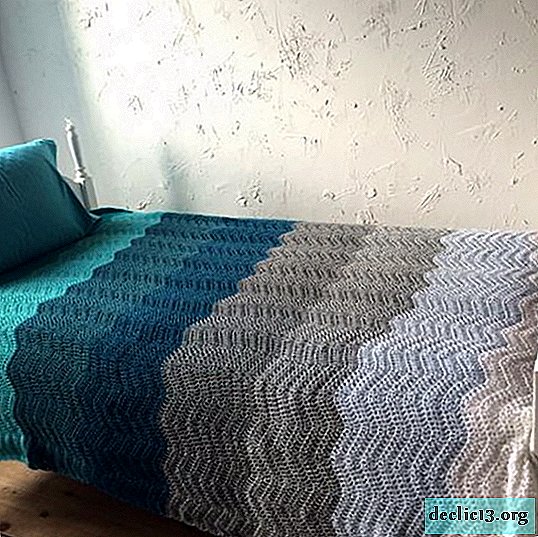

DIY making
Before making the bedspreads with your own hands, you need to prepare everything that is needed in the knitting process:
- yarn, the amount of which depends on the size of the product, the thickness of the thread and the selected pattern;
- knitting needles or hook.
The knitting pattern depends on the selected tool. When choosing a pattern, it is worth considering the following recommendations:
- if the product is intended to decorate the foot of the bed, then it is better to prefer braids that will give a feeling of warmth and comfort;
- for a nursery, you should choose a simple ornament or a completely smooth surface;
- a thin openwork bedspread is suitable for a girl’s bedroom or a newborn’s crib;
- a plaid of squares of different colors will decorate the interior in a country style or a sofa in the country;
- if the walls in the room are made in a rough style, then a plaid of thick yarn will help to soften them.
In cases where the room is very small, it is better not to choose a product from bulk thick yarn - it will take up a lot of space. It is worth giving preference to a model of woolen thread.
 Oblique knitting
Oblique knitting Children's plaid
Children's plaid Thin openwork bedspread
Thin openwork bedspread Knitted by squares
Knitted by squaresSpokes
Before knitting a bedspread on a bed, you need to determine the type of yarn and the size of the future product. To make a blanket you will need:
- yarn of several colors;
- knitting needles;
- strong thread for stitching parts of the future product together.
After everything is prepared, you can start knitting. Sequencing:
- We collect 8 loops on the needles.
- We knit an even square, alternating rows with wrong and front loops. Now you need to make the final row and tie a thread on a knot.
- Next, we knit the same square with yarn of a different color, repeat all the above steps.
- We turn the resulting rectangle and tie it to the side according to the same principle.
- The next step is the strapping of the other side of the obtained workpiece, then double length, 8 rows.
- We continue to tie the edges of the part, constantly increasing the length of the track, while the width remains unchanged.
- In the above way, it is necessary to make several squares (their exact number directly depends on the length and width of the future product).
- Now the blanks must be sewn together from the wrong side, resulting in an even canvas of the future bedspreads.
- The final step will be the binding of the edges of the product using the front surface technique.
In the process of knitting, it is important to ensure that the loops do not come off, if any of them looks ugly in the knitted row, it is better to immediately dissolve and remake.
If desired, the finished bedspread can be decorated with beads or ribbons. Products will look good, the edges of which are treated with silk edging, lace, braid. In some cases, the sides of the plaid can be decorated with tassels or fringe.

 We collect 8 loops
We collect 8 loops We knit out an even square and make the final row
We knit out an even square and make the final row We knit the same square with a yarn of a different color
We knit the same square with a yarn of a different color Expand, tie the side
Expand, tie the side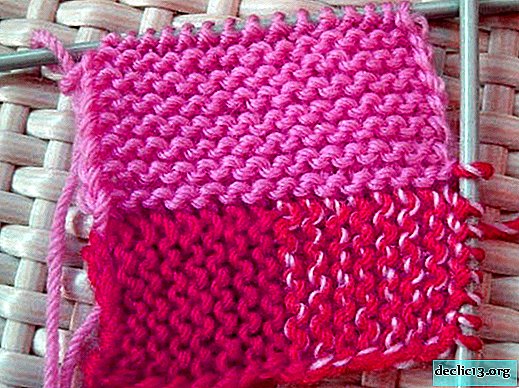 Knit another strip of a different color and 8 rows
Knit another strip of a different color and 8 rows This way you can tie several squares
This way you can tie several squares Sew the squares together from the wrong side
Sew the squares together from the wrong side Ready knitted bedspread
Ready knitted bedspreadCrochet
Crochet pattern depends on the method selected. For a large bedspread, it is better to prefer the manufacture of squares, which are subsequently connected to each other. To do this, you need:
- Collect four air loops and close them in a circle using a connecting post.
- After knitting two lifting stitches and a double crochet. Thus, complete eleven loops. In the process, it is important to ensure that the canvas does not move out.
- Dial three lifting loops and a double crochet, an air loop.
- Further, according to the planned pattern, under each double crochet - two without it and with an air loop after.
- Similarly, we knit the whole row.
- After repeating every third loop of the circle. For the remaining rows we knit the pattern of the previous one.
According to this scheme, squares are made, which are subsequently stitched. At the end, all unnecessary threads must be cut, having previously been tied. Before use, the product must be washed and ironed from the inside out.

 Solid thread option
Solid thread option


 Variant with multi-colored threads
Variant with multi-colored threads Finished plaid
Finished plaidDeciphering schemes
The picture of the future product depends on the chosen scheme, which contains a set of repeating elements. It can be written out in text, but it will be difficult to repeat the mating in this case. Therefore, symbols are used to image a particular pattern. When knitting, you must remember:
- schemes are read from bottom to top;
- the rows are read in turn: one from right to left, next from left to right;
- rapport between the arrows must be repeated constantly;
- circular rows are read from right to left.
Loops outside the area, which is limited by arrows, are knitted only at the beginning and end of the row.
Designations you need to understand for crocheting:
- cross - a single crochet, which makes the product denser;
- the letter "T" is a half-column with a crochet. Less dense rows are obtained from it;
- the letter "T" is crossed out - a single crochet. Often used in aerial patterns, for example, in a sirloin net;
- the letter "T" with two dashes is a column with the same number of wraps. It is widespread in openwork;
- the letter "T" with three dashes is a column with the specified number of wraps.
In patterns for knitting, the following symbols are used:
- vertical line - front loop;
- horizontal strip - wrong side;
- circle - yarn.
Other symbols are found in the schemes, but for a simple knitting the above notation is quite enough.
Knitted bedspreads are very beautiful and functional interior items. Alas, not all possess the skills for making such rugs. You can, of course, purchase a finished bedspread, but it is much more pleasant to make it yourself.











